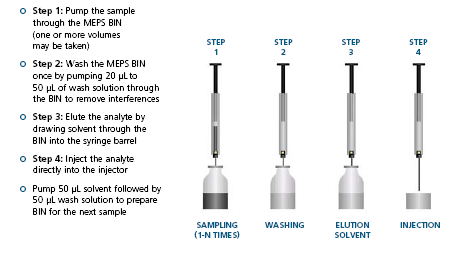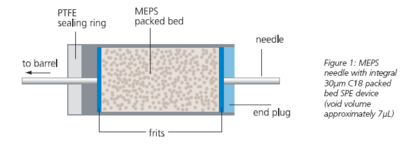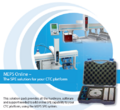Micro Extraction by Packed Sorbent
From LEAP
(→MEPS Online Kit Application Index) |
|||
| Line 115: | Line 115: | ||
* A09 Cyclodextrins from Urine | * A09 Cyclodextrins from Urine | ||
* A10 Dipterex in Serum | * A10 Dipterex in Serum | ||
| - | + | * A11 Diterpene Glycosides from Tea Extract | |
| - | + | ||
* A12 Fatty Acids from Serum | * A12 Fatty Acids from Serum | ||
* A13 Homovanillic Acid from Plasma | * A13 Homovanillic Acid from Plasma | ||
Revision as of 22:08, 23 October 2009

| SPE Applications |
| Application Type | |
| STANDARD AND SPECIAL | |
| Application ID | |
| MEPS | |
| Description | |
| Micro Extraction by Packed Sorbent (MEPS) |
Contents |
Overview
Micro Extraction by Packed Sorbent* (MEPS) is a new development in the field of sample preparation by solid phase extraction (SPE), and is a result of a collaboration between SGE and Mohamed Abdel-Rehim (AstraZeneca) and Lars G. Blomberg (University of Karlstead) Automation of MEPS is accomplished with the PAL Series of CTC Autosamplers. MEPS is the miniaturization of conventional SPE packed bed devices from milliliter bed volumes to microliter volumes. The MEPS approach to sample preparation is suitable for reversed phases, normal phases, mixed mode or ion exchange chemistries. MEPS is available in a variety of common SPE phases. The cartridge (Patent Pending) contains the stationary phase, and is built into the syringe needle. With a typical void volume of a few μL, the MEPS elution is compatible with GC and LC inlets making it ideal for automated on-line SPE on the CTC PAL platform. MEPS kits are exclusively available worldwide through LEAP Technologies and SGE Analytical Science.
MEPS performs the same function as SPE, namely the purification or speciation of samples, but with some significant differences:
- MEPS works with much smaller samples (as small as 10µL) than full scale SPE
- MEPS can be fully automated – the sample processing, extraction and injection steps are performed on-line using the same syringe
- MEPS is applicable to GC and LC
- Significantly reduces the volume of solvents and sample needed
MEPS online is an SPE solution for rapid development, in a variety of matrices; plasma, serum, whole blood, urine, aqueous
MEPS for PAL Systems is distributed by SGE & LEAP Technologies.
Benefits of MEPS
- MEPS allows SPE methodology to be applied to small sample volumes.
- MEPS can be integrated into autosampler robotics and allows on-line use of SPE.
- MEPS can reduce sample and reagent consumption and waste disposal.
- Double pass flows can reduce the weakly bound fraction.
- MEPS is field portable for remote sampling with or without the use of automated equipment.
- MEPS is adaptable for other analytical techniques including immunoassay and off-line analysis by NMR, IR and other methods.
Solid-phase extraction (SPE) has revolutionized sample preparation. Variations on the technique offer enhanced recovery, greater speciation and reduced solvent and sample consumption over other techniques.
Micro-Extraction Packed Sorbent (MEPS) is the miniaturization of conventional SPE from milliliter to microliter bed volumes that allows SPE to be used with very small samples. The manipulation of the small volumes is achieved with a precision gas tight syringe. With a typical void volume of 7μL, the MEPS
elution is compatible with GC and LC inlets making it ideal for integration into an automated sampling system for on-line SPE. In most cases, MEPS allows the same level of sample concentration as is
possible with off-line conventional SPE while providing opportunities for truly hybrid multi-dimensional methods. MEPS methods may be readily adapted from established SPE methods including those based on mixed mode or complex chemistries.
Like SPE, MEPS is for use with liquid samples (either normal or reversed phase) and yields four fractions: the unretained, weakly bound, strongly bound and irreversibly bound. However, because MEPS is a double pass system (sample and solvent enter and exit from the bottom of the bed, the weakly bound fraction (commonly the interferences eliminated by washing) is less strongly bound. The irreversibly bound fraction affects MEPS and conventional SPE and is usually associated with sorbent wetting rather than sample purification
and so the irreversible binding of matrix material from one sample does not preclude reuse of the device for a sample of the same type.
Like conventional SPE, the number of times the device can be reused is
dependent on the sample matrix. For simple applications, MEPS devices have
been used successfully for >50 cycles.

Available for both GC & LC applications. There are over 65 pre-set methods.
Significant Markets
- Natural Products
- Environmental
- Food & Beverage
- Pharmaceuticals
Sample Methods
- Aflatoxin B2 and M2 Metabolite
- Amphetamine
- Catecholamines
- Cyclosporin
- F-2 Mycotoxin
- Opiate Anagelesics
- Phthalate Esters
- Prostaglandins
- Persistent Organic Pollutants (PAH, PCB, and Pesticides)
- Steroid Acids
- S-triazine Herbicide (Atrazine)
- Vitamin A, D, and E
Photos
Publications
![]() Information specific to MEPS for CTC Autosamplers MEPS Online – The SPE solution for your CTC platform
Information specific to MEPS for CTC Autosamplers MEPS Online – The SPE solution for your CTC platform
MEPS Applications
![]() APPLICATION OF MEPS COUPLED WITH GAS CHROMATOGRAPHY TIME-OF-FLIGHT MASS SPECTROMETRY (GC-TOF MS) IN ANALYSIS OF BROMINATED FLAME RETARDANTS IN WASTE WATER
APPLICATION OF MEPS COUPLED WITH GAS CHROMATOGRAPHY TIME-OF-FLIGHT MASS SPECTROMETRY (GC-TOF MS) IN ANALYSIS OF BROMINATED FLAME RETARDANTS IN WASTE WATER
![]() Application to Opium Contaminated Animal Feeds
Application to Opium Contaminated Animal Feeds
![]() ON-SITE SAMPLE PREPARATION USING MEPS FOR WASTE WATER ANALYSIS
ON-SITE SAMPLE PREPARATION USING MEPS FOR WASTE WATER ANALYSIS
![]() FALSE POSITIVE DRUG TESTS FROM CONTAMINATED FEED
FALSE POSITIVE DRUG TESTS FROM CONTAMINATED FEED
![]() ANALYSIS OF BROMINATED FLAME RETARDANTS IN WASTE WATER
ANALYSIS OF BROMINATED FLAME RETARDANTS IN WASTE WATER
More Info
![]() MEPS web site by SGE including product brochure
MEPS web site by SGE including product brochure
![]() The Column article "It's a Small World"
The Column article "It's a Small World"
![]() The Column article "On-Site Sample Preparation Using MEPS for Wastewater Analysis
The Column article "On-Site Sample Preparation Using MEPS for Wastewater Analysis
MEPS Online Kit Application Index
ALKALOIDS
- A01 3,4-Diaminopyridine from Urine (Lambert-Eaton)
- A02 Alkylbenzyl Dimethylammonium Chlorides from Plasma
- A03 Amino Acids from Urine
- A04 Basic Nucleosides from Aqueous Solution
- A05 Bio-fl avonoids from Red Wine
- A06 Casuarine in Plant Extract
- A07 Catecholamines from Urine
- A08 Cyclodextrins from Plasma
- A09 Cyclodextrins from Urine
- A10 Dipterex in Serum
- A11 Diterpene Glycosides from Tea Extract
- A12 Fatty Acids from Serum
- A13 Homovanillic Acid from Plasma
- A14 Isofl avones from Plant Extract
- A15 Mixed Aromatic Amines from Urine and Plasma
- A16 Nicotine and Cotinine from Plasma
- A17 Nucleosides from Aqueous Solution
- A18 Nucleosides from Plasma
- A19 Nucleosides from Urine
- A20 PEG 400 in Serum
- A21 Persistent Organic Pollutants PAH, PCB and Pesticides in Blood
- A22 Persistent Organic Pollutants PAH, PCB and Pesticides in Plasma
- A23 Persistent Organic Pollutants PAH, PCB and Pesticides in Serum
- A24 Pesticides and PCB in Fats
- A25 Phenylanaline from Plasma
- A26 Prostaglandins from Urine
- A27 Prostaglandins from Whole Blood
- A28 Salsoline from Plasma
- A29 Steroid Acids from Serum
- A30 Tryptophan from Plasma
- A31 Vanillymandelic Acid from Plasma
- A32 Xanthines (Caffeine) from Serum
- A33 Xanthines (Theophylline) from Serum
ENVIRONMENTAL
- E01 Carbamate Insecticide (Aldicarb) from Water
- E02 PAH and PCB in Contaminated Soi
- E03 Phenols in water
- E04 Phthalate Esters in Water
- E05 S-triazine Herbicide (Atrazine) in Soil
FOOD & BEVERAGE
- F01 Afl atoxin B2 and M2 Metabolite Trace Analysis in Milk
- F02 Chloroacetanilide Herbicides (Acetochlor and Metolachlor )in Contaminated Water
- F03 F-2 Mycrotoxin Trace Analysis in Cereal
- F04 Fatty Acid Methyl Esters (Long Chain) in Fermentation medium
- F05 Omega 6 Fatty Acid in Malt Lipid Fractions
- F06 Pigment Anthocyanidins in Wine
- F07 S-triazine Herbicide (Atrazine) in Cereal
- F08 Sulfonamide Trace Analysis in Meat
PHARMACEUTICALS
- P01 Acetazolamide and Bumetanide in Urine
- P02 Acetazolamide in plasma
- P03 Amiodarone, Fendiline and Procainamide in Serum
- P04 Amphetamine in Plasma
- P05 Analgesics in Serum; Paracetamol and Tramadol
- P06 Anesthetics in Serum; Benzocaine, Mepivacaine, Procaineand Lidocaine
- P07 Antidepressants (Trycyclics) in Blood
- P08 Antidepressants (Trycyclics) in Urine
- P09 Atenolol in Plasma
- P10 Barbiturates in Serum; Barbital, Amobarbital, Phenobarbital,Secobarbital
- P11 Barbiturates in Urine; Barbital, Amobarbital, Phenobarbital,Secobarbital
- P12 Carbamazepine, Phenobarbital and Primidone in Serum
- P13 Chloramphenicol in Eye Drops
- P14 Cimetidine in Plasma
- P15 Cyclosporin in Blood
- P16 Erythromycin and Clarithromycin in Urine
- P17 Minor Tranquilizers (Benzodiazepines) in Urine or Serum
- P18 Minor Tranquilizers (Diazepam and Lorazepam) in Hair
- P19 Opiate Analgesics in Blood; Morphine and Codeine
- P20 Propranolol in Serum
- P21 Stobadin from Serum
- P22 Vitamin A, D and E in Supplements
- P23 Vitamin D3 and Metabolites in Serum
LEAP provides automated workstation instrumentation solutions based on the LEAP CTC PAL X, Y, Z syringe only autosampler robot from LEAP Technologies. This extremely flexible, precise, and adaptable liquid handling robotic platform is available in a variety of lengths and options depending on the requirements of your sample preparation and injections for your UHPLC, LC or GC chromatography.LEAP offers full support and service for the PAL platform in addition to being able to write custom macros, cycles, and scheduling to your applications. Please contact LEAP Technologies on how we can help you get maximized throughput with flexible pipetting automation solutions.
Contact LEAP
For additional information about LEAP and the PAL Platform, please contact LEAP Technologies. |






